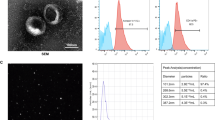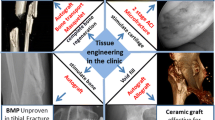Abstract
The purpose of this study was to test the effect of Runx-2-transfected hASCs to heal the defect created on proximal tibiae and calvaria of immunosuppressed rats. Three kinds of hASCs (untransfected, pECFP-transfected ASCs or Runx-2-transfected ASCs) were cultured under osteogenic medium. Osteoblastic differentiation was measured by ALP staining on day 7 and osteoid matrix formation was observed by alizarin red staining on day 14 after osteogenic induction. Osteogenic potential in long bone defects were tested via 6 mm-sized circular defect on proximal tibiae of 9 immunosuppressed rats. Untransfected ASCs, pECFP-transfected ASCs or Runx-2-transfected ASCs embedded in fibrin scaffold were implanted in the defect (N=3 in each group). In order to assess the in vivo osteogenic capability of Runx-2-transfected ASC in intramembanous ossification, two critical size bone defects were created on parietal bone of 12 immunosuppressed rats. The defects were filled with fibrin scaffold containing pECFP-transfected ASCs, Runx-2-transfected ASCs or no cell (N=4 in each group). Runx-2 transfected ASCs showed much stronger activity of ALP and greater formation of osteoid matrix compared with untransfected ASCs or pECFP-transfected ASCs 7 and 14 after osteo-induction, respectively. When the volume of regenerated bone was compared from gross examination and radiographs after 5 weeks in the proximal tibial defect model, the defects treated with Runx-2-transfected ASCs had the greatest area of healed bone compared with other groups. In the calvarial defect model, Runx-2-transfected ASCs had significantly increased area healed with bone (p<0.05) as well as better quality of regenerated bone compared with defects which was treated with untransfected ASCs from gross and micro-CT examination 8 weeks after implantation. The implanted human cells persisted in the newly regenerated bone in defects treated with pECFP-ASCs and Runx-2-transfected ASCs. In conclusion, Runx-2-transfection significantly increased the osteogenic potential of ASCs in the in vivo orthotopic models.
Similar content being viewed by others
References
TA Einhorn, The science of fracture healing, J Orthop Trauma, 19, S4 (2005).
JO Hollinger, JC Kleinschmidt, The critical size defect as an experimental model to test bone repair materials, J Craniofac Surg, 1, 60 (1990).
MD McKee, Management of segmental bony defects: the role of osteoconductive orthobiologics, J Am Acad Orthop Surg, 14, S163 (2006).
CH Evans, Gene therapy for bone healing, Expert Rev Mol Med, 12, e18 (2010).
DH Kim, R Rhim, L Li, et al., Prospective study of iliac crest bone graft harvest site pain and morbidity, Spine J, 9, 886 (2009).
C Delloye, O Cornu, V Druez, et al., Bone allografts: What they can offer and what they cannot, J Bone Joint Surg Br, 89, 574 (2007).
PA Zuk, M Zhu, P Ashjian, et al., Human adipose tissue is a source of multipotent stem cells, Mol Biol Cell, 13, 4279 (2002).
PA Zuk, M Zhu, H Mizuno, et al., Multilineage cells from human adipose tissue: implications for cell-based therapies, Tissue Eng, 7, 211 (2001).
S Nathan, De S Das, A Thambyah, et al., Cell-based therapy in the repair of osteochondral defects: a novel use for adipose tissue, Tissue Eng, 9, 733 (2003).
GR Erickson, JM Gimble, DM Franklin, et al., Chondrogenic potential of adipose tissue-derived stromal cells in vitro and in vivo, Biochem Biophys Res Commun, 290, 763 (2002).
YD Halvorsen, D Franklin, AL Bond, et al., Extracellular matrix mineralization and osteoblast gene expression by human adipose tissue-derived stromal cells, Tissue Eng, 7, 729 (2001).
GI Im, YW Shin, KB Lee, Do adipose tissue-derived mesenchymal stem cells have the same osteogenic and chondrogenic potential as bone marrow-derived cells? Osteoarthritis Cartilage, 13, 845 (2005).
SP Bruder, BS Fox, Tissue engineering of bone. Cell based strategies, Clin Orthop Relat Res, 367 Suppl, S68 (1999).
G Turgeman, DD Pittman, R Muller, et al., Engineered human mesenchymal stem cells: a novel platform for skeletal cell mediated gene therapy, J Gene Med, 3, 240 (2001).
J Park, J Ries, K Gelse et al., Bone regeneration in critical size defects by cell-mediated BMP-2 gene transfer: a comparison of adenoviral vectors and liposomes, Gene Ther, 10, 1089 (2003).
H Tsuda, T Wada, Y Ito, et al., Efficient BMP2 gene transfer and bone formation of mesenchymal stem cells by a fibermutant adenoviral vector, Mol Ther, 7, 354 (2003).
Z Zhao, Z Wang, C Ge, et al., Healing cranial defects with AdRunx2-transduced marrow stromal cells, J Dent Res, 86, 1207 (2007).
Z Zhao, M Zhao, G Xiao, et al., Gene transfer of the Runx2 transcription factor enhances osteogenic activity of bone marrow stromal cells in vitro and in vivo, Mol Ther, 12, 247 (2005).
T Komori, H Yagi, S Nomura, et al., Targeted disruption of Cbfa1 results in a complete lack of bone formation owing to maturational arrest of osteoblasts, Cell, 89, 755 (1997).
F Otto, AP Thornell, T Crompton, et al., Cbfa1, a candidate gene for cleidocranial dysplasia syndrome, is essential for osteoblast differentiation and bone development, Cell, 89, 765 (1997).
T Komori, Regulation of osteoblast differentiation by transcription factors, J Cell Biochem, 99, 1233 (2006).
F Otto, H Kanegane, S Mundlos, Mutations in the RUNX2 gene in patients with cleidocranial dysplasia, Hum Mutat, 19, 209 (2002).
JS Lee, JM Lee, GI Im, Electroporation-mediated transfer of Runx2 and Osterix genes to enhance osteogenesis of adipose stem cells, Biomaterials, 32, 760 (2011).
BA Byers, RE Guldberg, DW Hutmacher, et al., Effects of Runx2 genetic engineering and in vitro maturation of tissueengineered constructs on the repair of critical size bone defects, J Biomed Mater Res A, 76, 646 (2006).
Author information
Authors and Affiliations
Corresponding author
Rights and permissions
About this article
Cite this article
Lee, J.M., Kim, E.A. & Im, GI. Healing of tibial and calvarial bone defect using Runx-2-transfected adipose stem cells. Tissue Eng Regen Med 12, 107–112 (2015). https://doi.org/10.1007/s13770-014-0070-3
Received:
Accepted:
Published:
Issue Date:
DOI: https://doi.org/10.1007/s13770-014-0070-3




